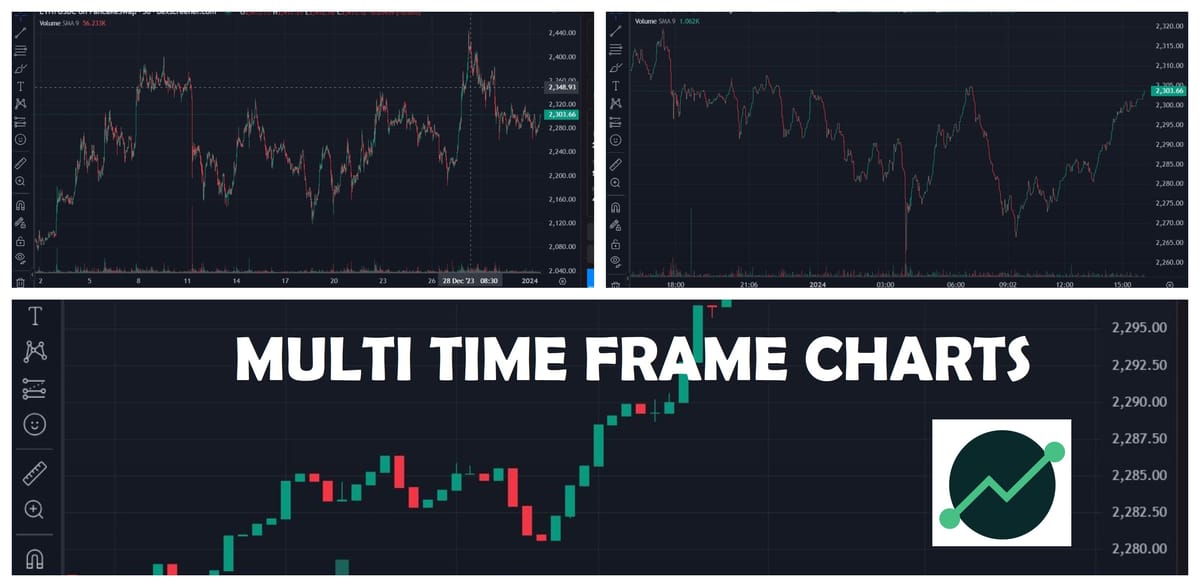How to Spot Entry Signals with Price Action Scanners

Do you know?
Studies by the CMT Association (Chartered Market Technician Association) in 2021 found that over 70% of traders struggle with identifying optimal entry points.
Let's be honest,
Even seasoned traders grapple with this challenge.
You spend hours analyzing charts, researching companies, and formulating strategies, only to get stumped when it comes to pulling the trigger.
Are you jumping in too early, fueled by FOMO (fear of missing out)?
Or are you waiting for the "perfect" moment that never arrives?
If you identify with this struggle, you're not alone.
Thankfully,
The world of trading has evolved,
It now offers a powerful tool to combat both emotional impulses and the time-consuming task of manual chart analysis:
These innovative software programs keep scanning the market for specific price movements and Chart patterns that might indicate high-probability entry signals.
By incorporating price action scanners into your trading strategy, you can;
1. Potentially remove emotion from the equation,
2. focus on objective signals, and
3. make more informed entry decisions that align with your trading goals.
This blog will delve into the top 3 ways you can leverage price action scanners to find those elusive entry opportunities and potentially navigate the market with greater confidence and discipline.
So,
Let's move Right Away!
Option 1: Using Support and Resistance in Price Action Scanners:
We all know that Support and resistance levels are like a tug-of-war between buyers and sellers.
Around Support buyers typically step in to prevent the price from falling further, while around resistance sellers tend to materialize and halt price advances.
This presents us with an excellent opportunity to enter trades around these areas.
Price action scanners excel at highlighting these valuable insights for your trading strategy.
You can enter a long trade (buying) after a breakout above resistance, anticipating the price to continue rising.
Conversely, you can enter a short trade (selling borrowed shares) after a breakout below support, expecting the price to keep falling.
And here is an interesting part
The price doesn't always break through support or resistance. It can also bounce off these zones.
A strong bounce-off support with increased volume suggests buyers are stepping in, potentially indicating an upside move. You might consider a long entry here.
Conversely, a price rejection at resistance with increased volume suggests sellers are halting the advance. You might consider a short entry or waiting for a confirmed breakout below resistance.
Scanner Filters for Support and Resistance
To Identify Support and Resistance,
You can Filter for the number of times touched (X) set to a value between 2-5.
The "number of times touched" filter focuses on how many times the price has hit a specific level in the past (represented by "X"). A higher value for "X" (typically between 2 and 5) signifies a stronger support or resistance zone.
You can choose a timeframe relevant to your strategy (e.g., 20-day high for swing trading, 52-week high for long-term investing).

These filters identify areas where the price has consistently faced buying or selling pressure in the past.
For Price Touches and Breakouts:
You can filter for stocks where Price touches or closes within a certain percentage (e.g., 2%) of the identified support/resistance level.
This captures potential tests of the zone without overly strict criteria.
There is one slightly advanced filter as well.
You can add this Filter for breakouts where Price closes above resistance or below support for X consecutive periods (e.g., 2 days) with volume exceeding Y% above average daily volume (e.g., 20%).
This will ensure a decisive breakout with increased volume for a potentially stronger signal.
Whatever, Filter you choose,
It is always better to test support and resistance with
Volume Confirmation:
For Volume Confirmation, you can Set the volume filter to a value that represents a significant increase for the specific stock you're scanning. You can use a percentage increase over the average daily volume (ADV) or a specific volume threshold (e.g., twice the ADV)
This helps differentiate minor fluctuations from potentially impactful moves.
As an Optional Filter, you can also add a filter for false Breakout Prevention
For this, you can Look for breakouts that hold above/below the level for X additional periods (e.g., 2 days) after the initial breakout.
This helps eliminate fleeting price spikes and false breakout signals.
Option 2: Breakouts in Price Action Scanners
A breakout occurs when the price decisively breaks above resistance or below support. This can signal a potential shift in the underlying trend.
Breakouts offer unique Entry Opportunities
For Example, As explained above, You might consider a long entry (buying) after a breakout above resistance. This anticipates the price to continue rising as the trend potentially shifts upwards.
Conversely, a breakout below support could be an opportunity for a short entry (selling borrowed shares), expecting the price to keep falling if the trend changes downwards.
But,
Apart from the usual opportunities through the support and resistance levels, A breakout often signifies increased buying or selling pressure, leading to higher volatility (price swings) compared to the consolidation period before the breakout.
This volatility can present short-term trading opportunities for traders comfortable with the increased risk. However, careful timing and risk management are crucial.
Here is how you can configure your scanner to identify and take advantage of breakouts
Entry Opportunities of Breakouts with Scanner
Beyond pinpointing support and resistance zones (covered in detail earlier), price action scanners excel at another crucial task:
identifying the direction of potential breakouts.
Scanners can be set to identify breakouts in either direction:
Upward Breakouts: When the price closes decisively above a previous resistance level, it might signal a potential trend reversal to the upside.
To filter for Stocks about to experience Upward Breakouts, you can look for stocks that close above the resistance level for X consecutive periods (e.g., 2 days) with volume exceeding Y% above the average daily volume (e.g., 20% above average).
Downward Breakouts: Conversely, a price closing firmly below a support level could indicate a trend reversal to the downside.
To Identify Stocks experiencing downward breakouts, you can Scan for stocks that close below the support level for X consecutive periods with volume exceeding Y% above the average daily volume.
These filters ensure the breakout is decisive (multiple closes above/below) and accompanied by increased buying/selling pressure (volume surge), strengthening the signal.
Similarly,
Breakouts can occur on various timeframes, from intraday charts to longer-term charts.
Scanners allow you to specify the timeframe you're interested in, focusing on breakouts relevant to your trading strategy.
To incorporate the timeframe, you have to choose the timeframe relevant to your strategy.
For short-term trades, you can use intraday charts (15-minute or hourly) with shorter breakout confirmation periods (e.g., 1-2 days).
For longer-term positions, you can use daily or weekly charts with extended confirmation periods (e.g., 3-5 days).
Here is another Important point to consider;
While basic breakouts are valuable, some advanced scanner filters can help refine your entries:
One such filter is to Prevent False Breakout.
It is because not every price movement above resistance or below support is a true breakout!
But the good news is,
Scanners can be set to look for breakouts that hold above/below the level for a certain number of periods, reducing the chances of false signals.
To Filter such false breakouts, you can Look for breakouts that hold above/below the level for X additional periods after the initial close (e.g., hold above resistance for 2 days after the breakout day).
This helps eliminate fleeting price spikes that might not translate into sustained trends.
You can also take into account the
Breakout Strength as well.
The size and speed of the price move during a breakout can indicate its strength. Scanners can filter for breakouts exceeding a certain percentage move or occurring within a specific timeframe, suggesting a potentially stronger trend.
To Filter for such stocks exhibiting this strength,
You can look for breakouts exceeding a specific percentage move (e.g., 3%) above/below the resistance/support level within a set timeframe (e.g., within the first hour of trading).
Why?
Because This filter will target potentially stronger breakouts with significant price movement in a short period.
Option 3: Using Break Retests:
Breakouts are exciting,
but sometimes they need a little "confirmation kiss" before you commit.
This kiss comes in the form of a break retest, where the price returns to the breakout level after the initial surge.
Here is how it works!
After the breakout, the price often pulls back towards the broken support/resistance level (the retest). This pullback can be caused by profit-taking from traders who bought during the initial breakout or by latecomers who see the retest as an opportunity to enter the trade at a slightly better price.
And thus comes the
Entry Opportunity
The key to the break and retest strategy is the retest. If the price finds support at the broken resistance level (bullish) or encounters resistance at the broken support level (bearish) during the retest, it can be a signal for a potential entry. This suggests the breakout might be genuine, and the new trend has a higher chance of continuing.
Why it works?
Because,
The retest acts as a confirmation of the initial breakout. If the price holds at the broken level during the retest, it indicates that the buying/selling pressure that caused the breakout is still present.
The retest can also offer a potentially better entry price compared to the initial breakout, especially for traders who are cautious about entering right after a breakout.
Scanners can be instrumental in highlighting these retests, potentially offering secure entry points.
Here's how scanners can elevate your break retest game:
Entry Opportunities Using Scanner on Break Retest
Here are some scanner settings and filters you can use to identify break and retest entry opportunities:
To Take advantage of the Break Retest,
First, You have to
Identify the Breakout
You can Set the scanner to identify stocks that have experienced a breakout above resistance (bullish) or below support (bearish) within a chosen timeframe (e.g., past day for day trading, past week for swing trading).
and As stated earlier,
You can also consider adding a volume filter to the breakout scan. Look for breakouts accompanied by increased volume, suggesting a stronger move and potentially a more reliable breakout.
Once you have a confirmed breakout,
You have to
Spot the Retest
You can set the scanner to identify instances where the price touches or briefly dips back below (bullish breakout) or rises above (bearish breakout) the broken support/resistance level after the initial breakout. You can set a percentage range for the touch/dip/rise (e.g., +/- 2% of the breakout level).
You can also make a
Confirmation on the Retest (Optional)
To do this, Look for stocks where the price finds support at the broken resistance (bullish) or encounters resistance at the broken support (bearish) during the retest with moderate volume.
High volume on the retest can indicate increased buying/selling pressure, which might not necessarily confirm the breakout's validity for entry.
The ideal timeframe for these filters depends on your trading style. Use a timeframe that aligns with your breakout filter (e.g., daily if you filtered for breakouts in the past day).
In conclusion
By harnessing the power of Price action Scanners to identify support and resistance zones, decode breakouts, and spot potential reversals, you can move beyond the limitations of manual chart analysis and emotional decision-making.
But Remember,
Scanners are just one weapon. Use them in conjunction with other technical indicators and sound risk management strategies to navigate the market with greater confidence and potentially elevate your trading game.
So,
Fire up your scanner, put these techniques into action, and happy hunting for those high-probability entry signals!
Trade Smarter!






